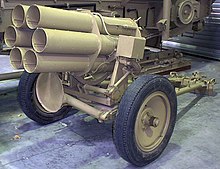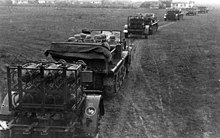Fog lights
The Nebelwerfer were German grenade launchers developed during the First World War . They were later developed into rocket launchers and were a common weapon of World War II .
Origin of name
There are various explanations for the origin of the name: It comes either from the name of the rocket researcher Rudolf Nebel , who actually developed the launcher in 1935, or from the originally planned property, the generation of fog by grenades. The so-called Nebeltruppe was formed in preparation for a possible chemical warfare . The designation served to conceal the actual destination. In any case, the name goes back to the inventor himself:
“I was a fighter pilot in World War I and invented the so-called fog throwers. I shot down enemy aircraft with these smoke cannons. I was then forbidden to continue working with these smoke cannons. But I had recognized that in rocket development a generous further development up to space travel can be guaranteed if that is done accordingly. "
Fog throwers 35 and 40
In addition to the various types of rocket launchers, which were known as Nebelwerfer, there were the 100 mm Nebelwerfer 35 and 40, which worked on the grenade launcher principle .
8 cm multiple thrower "Himmler organ"

This rocket launcher is a copy of the Soviet 82 mm rocket launcher BM-8 (“Katyusha”). There are photos of 8 cm multiple launchers on the mount of the Panzerwerfers 42 (Sd.Kfz.4) and the SOMUA MCG.
The 8 cm rockets are said to have had a range of 6000 m at a speed of 335 km / h.
15 cm fog thrower 41

The 15 cm Nebelwerfer 41 is the device commonly associated with the name Nebelwerfer. In the basic version, the weapon was able to fire six missiles with a caliber of 150 mm up to a maximum distance of 10,000 m in a volley of 10 seconds from smooth tubes of 1300 mm length arranged in a circle . The tubes each had three indented beads that served as guide strips for the rocket. The device was based on the mount that was also used with the 3.7 cm anti-tank gun , and weighed 540 kg when empty.
The structure of the 34.2 kg rocket body was unusual. The propellant charge of 6.5 kg was located in the head of the rocket and the gases flowed out through 26 side-mounted nozzles, and a twist stabilization was achieved by an additional inclination of the nozzles to the side . The fragmentation warhead , which was equipped with 2.4 kg of explosives, was located in the rear of the rocket, which meant that the warhead was slightly above the ground when it detonated, making it more effective. The ratio between the total weight of 34.2 kg and the weight of the explosive charge of only 2.4 kg should develop the greatest possible fragmentation effect in the target. Accordingly, the effect of pure gas blows was less significant .
The same launch tubes in two rows of five each were also mounted on armored Opel half-track vehicles (Sd.Kfz. 4/1 "Maultier") - under the designation " Panzerwerfer 42 ".
21 cm fog thrower 42

This launcher, equipped with five pipes arranged in a circle, each 1300 mm long, fired rockets weighing 110 kg over a range of 7850 m. The 1260 mm long rocket had a conventional structure with 22 nozzles attached to the stern and slightly inclined to generate swirl. The warhead, designed for explosive action, carried 38.6 kg of explosives. Although aerodynamically better designed than the rockets of the 15 cm smoke cannon, this rocket had a greater dispersion. Tests have shown that the pellets of the propellant charge collapsed before the end of the burning time, which resulted in a fluctuating increase in thrust.
This rocket was also launched from individual tubes attached under the wings of fighter planes and Bf-110 destroyers in order to be able to fight allied bomber formations from a greater distance. It was found that the twist stabilization with inclined nozzles produced a corkscrew-like trajectory . In order to counter this problem, one went over to an elongated single nozzle, which carried four knife tailplane wings that opened to the rear.
After inserting additional guide rails, the rockets of the 15 cm smoke cannon could also be fired from the 21 cm launcher tubes.
Heavy throwing device 40/41
The heavy throwing device 40 (wood) and the heavy throwing device 41 (steel) could fire both the 28 cm explosive device and the 32 cm flameproof device. In the case of the throwing device 40, four wooden packing boxes weighing 30 kg were housed on a 52 kg frame. It was replaced in 1941 by the heavy launcher 41 (steel), in which four rockets were housed in a 20 kg steel packing box on a 110 kg steel frame.
28 cm WK Spr
The 28 cm WK Spr was the propellant for the 15 cm launcher grenade 41 with an over-caliber warhead with a wall thickness of 1 mm. With a length of 1260 mm and a total weight of 82 kg, the warhead designed for pressure (gas strike) carried 50 kg of explosives. Because of the small propellant charge, only a range of around 1900 m was achieved and the spread was considerable. Since it was an area weapon, however, the spread could be accepted. The great effect earned the weapon the name " Stuka on foot", because of the starting noise it was also called "Howling Cow".
32 cm WK flame
The 32 cm WK flame had the same propellant charge , the warhead with a maximum diameter of 33.7 cm carried 50 liters of flame oil and a dismantling charge of 1.6 kg. With a length of 1300 mm and a total weight of 79 kg, a range of around 2200 m was achieved. One hit set fire to an area of around 200 m² (for example, a square of around 14 × 14 meters). It was customary to mix a rocket salvo so that the ratio of high explosive ammunition to flame ammunition was five to one. For example, the SdKfz 251/1 Ausf. B with a throwing frame usually carried five 28 cm WK Spr and a 32 cm throwing body Flamm in individual throwing frames attached to the side.
- In July 1943, the 30 cm Nb.W. 42 introduced. The 1098 kg weapon was an improved version of the 28/32 cm Nb.W. 41, in which six steel packing boxes were arranged in two rows one above the other.
- Because of the short range of the 28/32 WK. became the 30-cm-WK equipped with the propellant of the 21-cm rocket. 42 languages developed. The 127 kg heavy and 1249 mm long projectile, which carried 45 kg of explosives, had a range of about 4550 m.
See also
literature
- OKW: Regulation D 321 - The 10 cm fog thrower. - Preliminary device description and operating instructions. - 1939.
- OKW: Regulation D 1127 - 30 cm Nebelwerfer 42 - 1943.
- OKW: regulation H.Dv. 454/5 - Heeresfeuerwerkerei - Booklet 5 - Projectiles for artillery, smoke and grenade launchers - November 21, 1936.
Web links
Individual evidence
- ^ Frank Grotelüschen : Pioneer of rocket technology. In: Calendar sheet (broadcast on DLF ). March 21, 2019, accessed March 25, 2019 .



